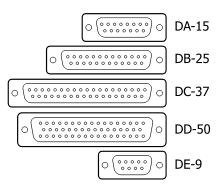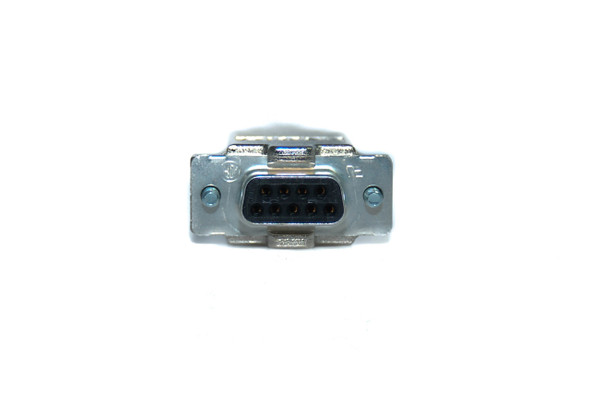Description
37-Pin D-Sub Cables (DB37) -- 37-Pin D-Sub cable assemblies are the perfect I/O solution for your DB37 d-sub equipped devices. The DB37 D-subminiature interface is typically used for RS-232 serial communications between PC's and peripheral devices. Our DB37 d-sub assemblies feature Quabbin Cable (8509) and Bel Stewart connectors (Male – 1-745492-8 & Female 1-745491-7) and TE hoods (180 Deg 5748676-1 & 90 deg 981-009-130R121)
We can handle all made in USA D-sub DB37 custom assemblies. Custom labeling and pinouts are available
History and Applications
A D-sub contains two or more parallel rows of pins or sockets usually surrounded by a D-shaped metal shield that provides mechanical support, ensures correct orientation, and may screen against electromagnetic interference. The part containing pin contacts is called the male connector or plug, while that containing socket contacts is called the female connector or socket. The socket's shield fits tightly inside the plug's shield. Panel mounted connectors usually have threaded nuts that accept screws on the cable end connector cover that are used for locking the connectors together and offering mechanical strain relief. Occasionally the nuts may be found on a cable end connector if it is expected to connect to another cable end (see the male DE-9 pictured). When screened cables are used, the shields are connected to the overall screens of the cables. This creates an electrically continuous screen covering the whole cable and connector system.

The D-sub series of connectors was introduced by Cannon in 1952.[1] Cannon's part-numbering system uses D as the prefix for the whole series, followed by one of A, B, C, D, or E denoting the shell size, followed by the number of pins or sockets, followed by either P (plug or pins[2]) or S (socket) denoting the gender of the part. Each shell size usually (see below for exceptions) corresponds to a certain number of pins or sockets: A with 15, B with 25, C with 37, D with 50, and E with 9.[3] For example, DB-25 denotes a D-sub with a 25-position shell size and a 25-position contact configuration. The contacts in each row of these connectors are spaced 326/3000 of an inch apart, or approximately 0.1087 inches (2.76 mm), and the rows are spaced 0.112 inches (2.84 mm) apart; the pins in the two rows are offset by half the distance between adjacent contacts in a row.[4] This spacing is called normal density. The suffixes M and F (for male and female) are sometimes used instead of the original P and S for plug and socket.
Later D-sub connectors added extra pins to the original shell sizes, and their names follow the same pattern. For example, the DE-15, usually found in VGA cables, has 15 pins in three rows, all surrounded by an E size shell. The pins are spaced at 0.090 inches (2.3 mm) horizontally and 0.078 inches (2.0 mm) vertically,[4] in what is called high density. The other connectors with the same pin spacing are the DA-26, DB-44, DC-62, DD-78 and DF-104. They all have three rows of pins, except the DD-78 which has four, and the DF-104 which has five rows in a new, larger shell.[5] The double density series of D-sub connectors features even denser arrangements and consists of the DE-19, DA-31, DB-52, DC-79, and DD-100. These each have three rows of pins, except the DD-100, which has four.
However, this naming pattern is not always followed. Because personal computers first used DB-25 connectors for their serial and parallel ports, when the PC serial port began to use 9-pin connectors, they were often labeled as DB-9 instead of DE-9 connectors, due to an ignorance of the fact that B represented a shell size. It is now common to see DE-9 connectors sold as DB-9 connectors. DB-9 nearly always refers to a 9-pin connector with an E size shell. The non-standard 23-pin D-sub connectors for external floppy drives and video output on most of the Amiga computers are usually labeled DB-23, even though their shell size is two pins smaller than ordinary DB sockets.
DA-26 male connector, sometimes incorrectly called DB-26HD or HD-26
Reflecting the same confusion of the letters DB with just D as mentioned above, high density connectors are also often called DB-15HD (or even DB-15 or HD-15), DB-26HD (HD-26), DB-44HD, DB-62HD, and DB-78HD connectors, respectively, where HD stands for high density.
Cannon also produced "combo" D-subs with larger contacts in place of some of the normal contacts, for use for high-current, high-voltage, or co-axial inserts. The DB-13W3 variant was commonly used for high-performance video connections; this variant provided 10 regular (#20) pins plus three coaxial contacts for the red, green, and blue video signals. Combo D-subs are currently manufactured in a broad range of configurations by other companies, including Amphenol, Conec, Teledyne Reynolds, Assmann Electronics, Norcomp, Positronic, Cinch, 3M, and Tyco. Some variants have current ratings up to 40 A; others are waterproof and meet IP67 standards.[citation needed]
A smaller type of connector derived from the D-sub is called the microminiature D, or micro-D, which is a trademark of ITT Cannon. It is about half the length of a D-sub.
A further family of connectors of similar appearance to the D-sub family uses names such as HD-50 and HD-68, and has a D-shaped shell about half the width of a DB25. They are common in SCSI attachments.
The original D-sub connectors are now defined by an international sta ndard, IEC 60807-3 / DIN 41652. The United States military also maintains another specification for D-subminiature connectors, the MIL-DTL-24308 standard.[4]
Typical applications
D-sub connectors.
Shown is a 9-pin male (DE-9M) connector (plug), and a 25-pin female (DB-25F) connector (socket). The hexagonal pillars (4-40 bolt) at both ends of each connector have a threaded stud fastening the connectors to the metal panel. They also have threaded sockets to receive jackscrews on the cable shell, holding the plug and socket together.
Communications ports
The widest application of D-subs is for RS-232 serial communications, though the standard did not make this connector mandatory. RS-232 devices originally used the DB25, but for many applications the less common signals were omitted, allowing a DE-9 to be used. The standard specifies a male connector for terminal equipment and a female connector for modems, but many variations exist. IBM PC-compatible computers tend to have male connectors at the device and female connectors at the modems. Early Apple Macintosh models used DE-9 connectors for RS-422 multi-drop serial interfaces (which can operate as RS-232). Later Macintosh models use 8-pin miniature DIN connectors instead.
On PCs, 25-pin and (beginning with the IBM-PC/AT) 9-pin plugs were used for the RS-232 serial ports; 25-pin sockets were used for parallel ports (instead of the Amphenol socket found on the printer itself, which was inconveniently large for direct placement on the expansion cards).
Many uninterruptible power supply units have a DE-9F connector on them in order to signal to the attached computer via an RS-232 interface. Often these do not send data serially to the computer but instead use the handshaking control lines to indicate low battery, power failure, or other conditions. Such usage is not standardized between manufacturers and may require special cables.
Network ports
DE9 connectors were used for some token ring networks as well as other computer networks.
The Attachment Unit Interfaces that were used with 10BASE5 "thick net" in the 1980s and 1990s used DA15 connectors for connectivity between the Medium Attachment Units and (Ethernet) network interface cards, albeit with a sliding latch to lock the connectors together instead of the usual hex studs with threaded holes. The sliding latch was intended to be quicker to engage and disengage and to work in places where jackscrews could not be used for reasons of component shape.
Information provided by https://en.wikipedia.org/wiki/D-subminiature















